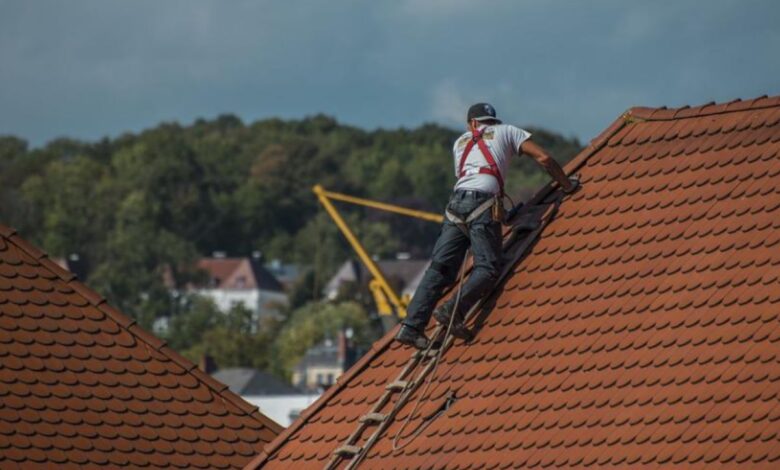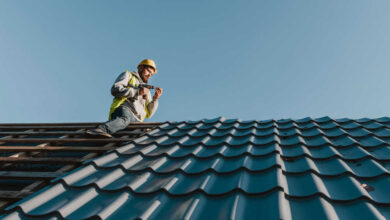A Complete Guide To Roof Tiles

The current economy offers many options, including tile roofing. The amazing thing about tile roofing is that, in addition to its visual beauty, people frequently choose it for its sturdiness and strength. This page provides a thorough analysis of tile roofing, including its benefits and drawbacks, varieties, and average price.
You may arrange a free inspection if you’re interested in installing roof tiles, and we can help you every step of the way. No matter what type of roofing issue you have, we can handle it.
What Is Tile Roofing?
For homeowners seeking the longest possible roof life, tile roofing provides among the most attractive roof solutions. Many tile roofs can survive 100 years or longer when constructed properly.
Several materials, such as baked clay or terra cotta goods, ceramic, and slate, are used to make roof tiles. Nevertheless, developments in technology have made it possible for producers to create tile roofing from a variety of materials, including metal, colored concrete, bitumen, and polymer sand.
What is the lifespan of a tile roof?
The longevity of tile roofing is arguably its greatest benefit. When it relates to strength and durability, it outperforms all other roof components. Some European structures feature tile roofs that have stood the test of time. To be more cautious, a modern tile roof can last 50 years on average if it is properly cared for and managed.
The advantages of tile roofing
The advantages of tile roofing and ways it can increase the value of your house are listed below.
1. The Long-Lasting of Tile Roofing
Tile roofs can last for 50 years or more if properly installed and maintained. The tiles themselves are made from ceramic or clay, which is fired in a kiln at very high temperatures.
2. The durability of Tile Roofing
As shown by the old structures with tile roofing that have stood the test of time, tile roofs are naturally durable. Hail and strong winds are reported to be withheld by concrete and clay tiles. Compared to concrete tiles, terra cotta tiles are more resistant and become harder with age.
3. Weather-Resistant Tile Roofing
Tile roofs are a common option for homeowners since they are strong and resistant to the elements. They can survive storms, rain, frost, and temperatures that are extremely hot or cold.
4. Tile Roofing Needs Low Maintenance
Tile roofing needs maintenance because of its toughness and harm resistance. Tiles are rarely found to create leaks, and fixes are not frequently necessary unless the tiles are seriously damaged.
The most popular types of tile roofing
Different varieties, colors, textures, and patterns are available for roof tiles. Their shape, weight, level of durability, and price all vary. To better comprehend their properties and what distinguishes them from one another, we shall decompose the nine most used forms of tile roofing.
- Metal-tile roofs
- Stone & Slate Tile Roofing
- Concrete Tile Roofing
- The roof of Composite Tile
- Clay Roof Tiles
- Polymer-Sand Roof Tile
- Bituminous Tile Roofing
- Copper Tile Roofing
- Solar Roof Tiles
Colors for Tile Roofing
Remember that the color of your tile roofing should go well with the color or style of your home’s architecture. If not, your home’s aesthetic appeal can decrease. Keep in mind which roof tiles provide a wide range of color choices when selecting the appropriate roof tile colors. Clay tiles come in a restricted number of hues, whereas synthetic and concrete tiles come in a wide range.
The disadvantages of tile roofing
Tile roofs are attractive, durable, and require little upkeep. However, they do have some disadvantages of their own, particularly if you reside in a chilly climate. Here are a few things to think about before investing in tile roofing.
- Price: A tile roofing process can be expensive; on average, it is twice as expensive as asphalt shingles. Clay tile can price between $675 and $1400 per square, and a concrete tile roof typically costs $400 to $450 every 100 SF. The most pricey tile is slate, which typically costs between $1000 and $4000 per square.
- Heavy Substance: Due to the weight of tiles, a sturdy structural foundation is required to sustain a tile roofing site effectively. Clay tiles have a maximum weight of 12 pounds per tile. To make sure that your house can handle a new tile roof, we highly advise scheduling a free assessment.
- Complicated to Install: Not your typical do-it-yourself activity, tile roofing. Make sure to include a qualified roofing contractor, one with much expertise in installing tile roofs. When correctly placed, tiles are precisely measured, arranged in a specified pattern, and meticulously inspected to ensure quality.
Bottom Lines
Remember the important elements you have to think about while choosing a tile roof. The sort of roofing tiles you pick should be determined by the design and construction of your home; the roof should complement both. Next, consider how durable each style of roof is before making your decision. Even though it could be a bit expensive, maintenance costs won’t be incurred.




